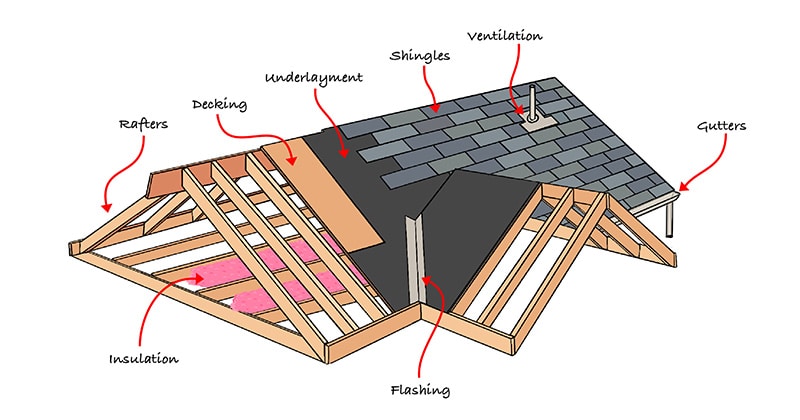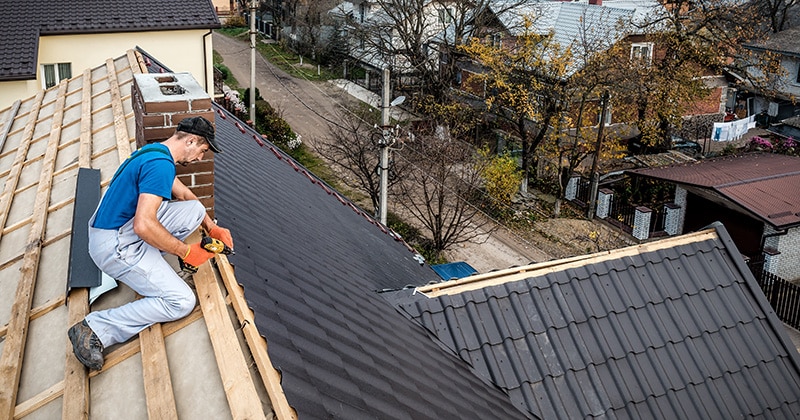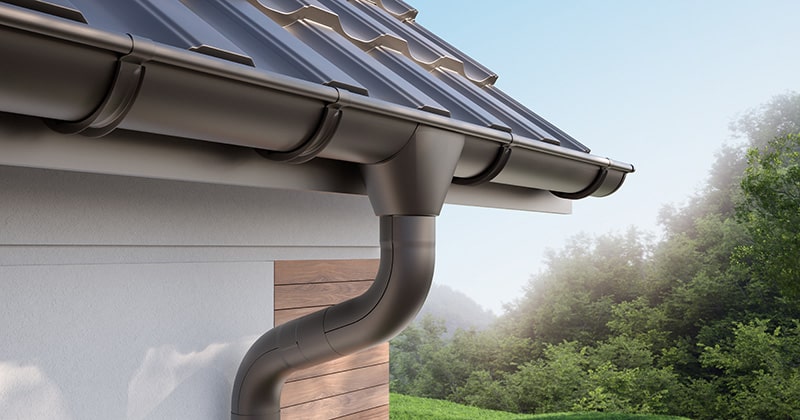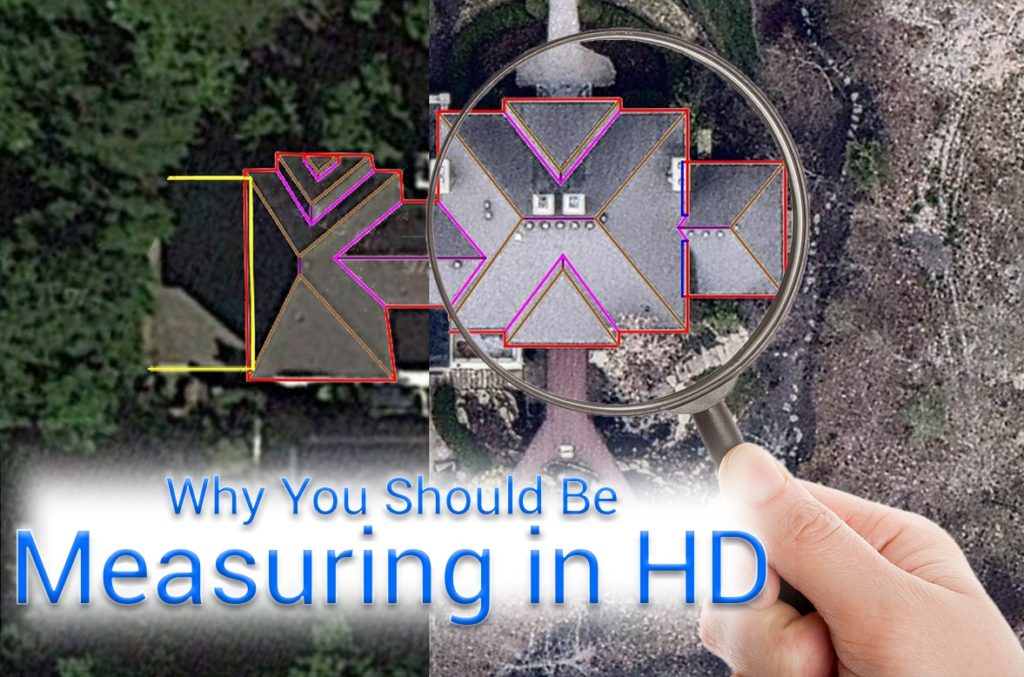The most common types of roofs last 20 to 80 years. Longevity depends heavily on materials and the quality of the work.
Of course, the roof covering needs to stand up to the elements. However, the other parts of the roof must also perform to maximize lifespan.
As a roofer, you need to understand how these different components contribute to the integrity of the roof.
For example, some structural parts of the roof may not need repair or replacement. But you still need to check to ensure these elements are intact and can support the roof. If you do not do this, the roof could fail prematurely, regardless of the quality of your work on other parts of the roof.
Some parts of the roof could affect other functions in a building. For instance, ventilation impacts a home’s heating, air conditioning, and moisture levels. Roof pitch is also fundamental for measuring and planning projects.
Roofers often need to explain the different parts of a roof and their functions to clients. Clients may not understand the necessity of certain components. For instance, they might balk at the idea of extra flashing to protect the valley.
RELATED ARTICLE: Roofing 101: How to Start a Roofing Company
Here is an overview of the different parts of a roof and how they affect quality and performance.

What Are the Different Parts of a Roof?
You can divide the parts of a roof into four categories. These are structural elements, drainage, ventilation, and exterior components. The performance of each part affects the integrity of the other three.
1. Structural Elements
These components are the base and support for the roof. They provide slope and stability to stand up against the elements. The main elements of this base structure are:
Rafters or Trusses
Rafters or trusses are the main supports for the roof. They are usually made from wood in homes. But rafters could also be steel in some buildings. They are typically angled to provide a slope to the roof.
Flat roofs do not have angled rafters. Instead, they rely on joists. These beams stretch across the roof to provide support, more like a floor foundation.
Roof Decking
Roof decking, also known as sheathing, attaches to the outside of the rafters. It’s made of plywood or a composite. The deck provides the base for shingles and any protective layers underneath them.
Collar Beams
These additional beams are common in areas with frequent storms or high winds. They offer more stability by connecting the rafters on either side of the roof. Collar beams aren’t always necessary, but they can strengthen the structure.
2. Drainage Components
These elements allow water to run off the roof. They also help with waterproofing and stop water damage. Adequate drainage is clearly critical to the integrity of the roof, but it can also be a less visible element. Clients may have questions about the function and necessity of each component. Here are some short definitions to help adequately explain the components and why they’re needed.
Underlayment
Underlayment is a solid, water-repellent barrier that completely covers the roof decking. It stops water from damaging the structural components and causing leaks inside the home. This part of the roof is usually made from synthetic materials.
Flashing
This metal component protects areas around roof elements like chimneys and vents. Flashing is a thin, flexible sheet that stops water from entering the gaps around these features.
Drip Edge Flashing
This integral type of flashing sits right at the edge of the roof. It directs water into the gutter and keeps moisture from seeping back into the decking beneath the underlayment and causing rot.
Gutters
Gutters attach to the edges of the roof. They collect water and direct the flow to downspouts that carry it away from the home. Usually made from aluminum, this system is necessary to avoid runoff pooling around the home’s foundation, causing flooding or foundation damage.
Some roofs have water or ice shields. These are underlayments that protect areas prone to water damage or ice buildup. They can consist of asphalt, composite, or rubber materials.
RELATED ARTICLE: Roof Estimating 101: How to Estimate a Roofing Job
3. Ventilation
Roof ventilation relies on small vents covered by slats or screens. Vents allow outside air to enter and expel hot, moist air from the attic.
Active vents rely on fans to draw air in or push out moist air. Passive vents rely on natural airflow patterns to push air through the attic.
Ventilation is important for climate control. The airflow pushes humidity out of the building. Vents also reduce moisture, which can cause mold growth.
4. Exterior Components
These are the most visible parts of the roof. They are the last layer of protection between the building and the climate.
Clients may be familiar with roof covering options, but there are other components they should be aware of as well. Here are the elements they should be aware of:
Roof Covering
Shingles are extremely common and cost-effective. They’re made from asphalt and composite materials and cover the roof deck and underlayment. They protect the roof from inclement weather and reflect sunlight.
Other roof coverings include metal roofing, wood shakes, and slate or clay tiles. The best option depends on the client’s budget and the climate in their location.
Ridge Cap
The ridge cap, made from metal or asphalt, sits on the very top of the roof. It protects the space where the two slopes of the roof meet. It prevents leaks and ice buildup.
Valley
The valley is the intersection of the two sides of the roof that the ridge cap covers. If a roof has more than two sides, the topmost area is called the hip.
Soffit
The soffit is at the bottom of the roof overhang. It can be wood, aluminum, or vinyl. It protects the overhang from the elements. It can also include vents to assist with airflow.
Fascia
The fascia is a narrow wood, metal, or composite strip covering the roof’s edge above the soffit. It serves as a cap for the bottom end of the rafters.
Eaves
The eaves, or overhang, is the part of the roof that extends beyond the walls of the building. This element keeps water from getting into the walls and foundation.
Other exterior elements can include skylights and dormers. Skylights are windows placed on the roof to allow natural light. Dormers are windows that extend from the roof and are covered with shingles on the top.
RELATED ARTICLE: Roofing Lead Generation: 6 Ways to Get More Roofing Leads

What Are the Signs that Part of a Roof Needs to be Replaced?
Some signs that a roof needs replacement are visible. But, you need to look beyond the surface components. Some evidence of roof problems could be in the attic or the home’s interior.
Here are the most common signs of roof issues:
Sagging
A sagging roof is a sign of structural damage. If part of the roof is bowing inward, it could be due to roof deck or rafter problems.
Actually, the damage to the structural elements usually comes from other issues. For instance, hidden leaks or poor ventilation lead to water damage. Over time, the moisture causes the deck or supports to rot. They lose their ability to support the roof.
In addition to fixing the deck or rafters, you need to find and repair leaks. Or, decide if you need to upgrade to active ventilation to limit moisture.
Interior Water Damage
You can often determine degrading roof integrity by looking inside a home. Water stains on the ceiling can be a sign of leaks. If clients have noticed signs of water damage, inspect the flashing and look for damage to shingles or fascia.
They should be aware this problem could require a complete roof replacement or repairs to specific parts of the roof.
Visible Damage
A visual inspection can reveal damage to the roof. Many clients will inspect their own roofs after a big storm or if they’ve also noticed leaks inside the home but still need a professional opinion.
A professional looking at the exterior elements can pinpoint the cause of the problems, such as lifting shingles or dented flashing that the client will likely miss.
Perform close visual inspections by climbing onto a roof. In some instances, technology can help you look for damage. For example, you can deploy a drone for roof inspection.
Shingle Residue
Asphalt residue can be a sign of aging shingles. Clients will often notice granules of asphalt in the gutters or at the bottom of downspouts after rain.
Roof Age
Materials, climate, and maintenance can affect roof longevity. But when a roof reaches the end of its expected lifespan, regular inspections can be helpful. Offering these scheduled checks can lead to the early detection of problems and keep your business on deck when repairs are needed.
As soon as you notice shingle residue in gutters or compromised flashing, you can suggest a roof replacement. The project may involve upgrading underlayment and adding new shingles and flashing. But, if you avoid damage or rot to the roof deck, the home or building owner can avoid expensive structural repairs.
Growth on Exterior Components
Moss needs moisture to grow. If you notice moss on the roof, it could be a sign that an area of the roof could be retaining water.
This problem alone does not necessarily mean the client needs to replace the roof. But it does mean you should inspect the area more closely to look for signs of damage or drainage problems.
RELATED ARTICLE: 9 Revolutionary New Roofing Technology Trends for 2024

How You Can Start Learning More About the Parts of a Roof Right Now
Look for resources to learn more about roof components and how to tell when they need replacement.
Research Manufacturers’ Websites.
Roof part manufacturers often have in-depth information on their components and how they fit into roof systems. This information is usually aimed at tradespeople, so it includes information about installation, performance, and replacement. For instance, manufacturer GAF has training resources for contractors.
Look for Resources from Trade Associations.
Trade associations offer training materials. For example, the National Roofing Contractors Association (NRCA) has courses and technical guides. Its website also allows you to search for articles on specific topics.
Work with an Experienced Roofer.
If you lack experience, you can look for work with a seasoned roofing contractor. This will provide you with hands-on skills development. You will likely learn about the different components and how to diagnose problems and make repairs.


